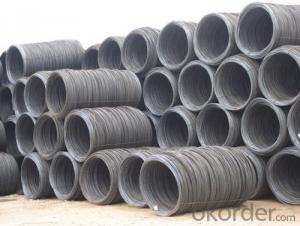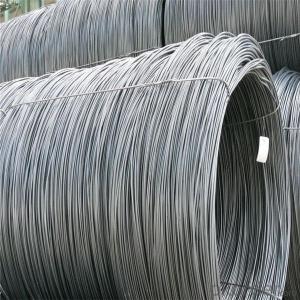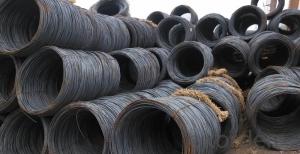GB Standard Steel Wire Rod with High Quality 9mm-10mm
- Loading Port:
- China Main Port
- Payment Terms:
- TT or LC
- Min Order Qty:
- 40 m.t
- Supply Capability:
- 15000 m.t/month
OKorder Service Pledge
OKorder Financial Service
You Might Also Like
Product Description:
Specifications of GB Standard Steel Wire Rod with High Quality 9mm-10mm:
Steel Grade: Q195 Standard:GB
Diameter: 9mm, 10mm
6.5mm can be drawing into 2mm/8.0mm can be drawing into 3mm
Each coil weight about 2MT
Chemical Composition:
Please kindly find our chemistry of our material based on Q195 as below for your information
Trademark | Rank | Chemical composition (quality score) % | |||||
C | Si | Mn | S | P | |||
| ≤ |
| ≤ | ≤ | |||
Q195 |
| 0.06-0.12 | 0.30 | 0.25 | 0.050 | 0.045 | |
Trademark | Rank | Pulling Test | |||||
Bend PointΔs/Mpa | Tensile Strength | Elongation Ratioδ5% | |||||
Thickness (Diameter) /MM | Thickness (Diameter) /MM | ||||||
≤16 | 16-40 | ≤16 | 16-40 | ||||
≥ | ≥ | ||||||
Q195 |
| 195 | 185 | 315-390 | 33 | 32 | |
Usage and Applications of GB Standard Steel Wire Rod with High Quality 9mm-10mm:
After hot-rolled the products shaped into coil and delivery as finished product, including round, square, rectangular, hexagonal and so on. Since most of the products are round, it is generally called wire rod. Carbon steel wire rod is widely used in construction and manufacturing. Carbon steel wire rod is mainly used for reinforcement of reinforced concrete and welded structure or reprocessed (roberts , nail, etc.) materials, especially used to produce wire drawing, welding electrode, nails, spring, electronic, precise machinery parts and so on.
Production Process of GB Standard Steel Wire Rod with High Quality 9mm-10mm:
Steel billet---Heating---Rolling---Water-cooling---Coiling---Cooling---Inspection---Bundling---Exworks
Packaging & Delivery of GB Standard Steel Wire Rod with High Quality 9mm-10mm:
Packaging Detail: products are packed in coil and then shipped by container or bulk vessel
Each coil weight: About 2MT
Delivery Detail: within 45 days after received deposit or original LC.
Label: to be specified by customer, generally, each bundle has 1-2 labels
Trade terms: FOB, CFR, CIF
FAQ:
Q1: How soon can we receive the product after purchasement?
A1: Within three days of placing an order, we will begin production. The specific shipping date is dependent upon international and government factors, but is typically one month.
Q2: How do you guarantee the quality of our products?
A2: We have established an advanced quality management system which conducts strict quality tests at every step, from raw materials to the final product. At the same time, we provide extensive follow-up service assurances as required.
Q3: The prices are invoicing on theoritical weight or on actual weight?
A3: We can do it in both manners, according to the customers' request.
Image of GB Standard Steel Wire Rod with High Quality 9mm-10mm


*If you would like to get our price, please kindlly inform us the size, standard/material and quantity. Thank you very much for your attention.
- Q: What are the different types of steel wire rod surface defect visualization techniques?
- There are several different types of steel wire rod surface defect visualization techniques, including visual inspection, magnetic particle inspection, ultrasonic inspection, and eddy current inspection.
- Q: What are the main factors affecting the magnetic properties of steel wire rod?
- The main factors affecting the magnetic properties of steel wire rod include its chemical composition, grain structure, heat treatment, and mechanical processing.
- Q: How is steel wire rod used in the manufacturing of wire for automotive airbags?
- Steel wire rod is indispensable in the manufacturing process of wire for automotive airbags as it serves as the primary material that undergoes various processes to produce the final wire utilized in the airbag system. To begin with, the steel wire rod undergoes a series of procedures to enhance its properties and render it suitable for airbag wire manufacturing. These procedures encompass cleansing, heating, and shaping the rod into the desired diameter and configuration. Additionally, the rod may be subjected to surface treatments to augment its resistance to corrosion and bolster its strength. Once the rod is prepared, it is drawn through a succession of dies to decrease its diameter and increase its length. This process, referred to as wire drawing, significantly heightens the wire's strength and flexibility. Typically, the wire is drawn multiple times to attain the necessary diameter and mechanical characteristics. Subsequent to the wire drawing process, further steps are taken to ensure that the wire complies with the specific requirements of automotive airbags. It may undergo additional heat treatments to amplify its strength and ductility, enabling it to endure the forces exerted during airbag deployment. The steel wire rod ultimately yields the final wire utilized in the fabrication of the airbag system. The wire is commonly woven or knitted to form a robust and pliable fabric that has the capability to expand rapidly upon airbag deployment. This fabric is subsequently integrated into the airbag module, which encompasses other components such as the inflator and cushion. All in all, the steel wire rod assumes a pivotal role in the manufacturing of wire for automotive airbags. It serves as the primary material that is processed and transformed into the final wire, which possesses strength, flexibility, and the ability to effectively safeguard occupants in the event of a collision.
- Q: How does the elongation of steel wire rod vary with different heat treatment processes?
- The elongation of steel wire rod is influenced by different heat treatment processes. Heat treatment involves subjecting the steel wire rod to specific temperatures and cooling rates to alter its structure and properties. One common heat treatment process for steel wire rod is annealing. During annealing, the wire rod is heated to a high temperature and then slowly cooled. This process relieves internal stresses and allows for the formation of a more uniform and ductile microstructure. As a result, the elongation of the steel wire rod typically increases after annealing. The increased elongation is due to the reduction in brittleness and the improved ability of the material to deform without fracturing. On the other hand, another heat treatment process called quenching and tempering involves rapid cooling followed by reheating and slow cooling again. Quenching hardens the steel wire rod, making it stronger and more resistant to deformation. However, this process can also make the material more brittle, reducing its elongation. The subsequent tempering process relieves some of the brittleness while maintaining the strength, resulting in a moderate elongation. In summary, the elongation of steel wire rod varies with different heat treatment processes. Annealing increases elongation by improving ductility and reducing brittleness, while quenching and tempering can result in a moderate elongation by balancing strength and brittleness. The specific heat treatment process chosen for steel wire rod depends on the desired mechanical properties and performance requirements for its intended application.
- Q: What are the different surface cleaning methods used for steel wire rod?
- There are several surface cleaning methods commonly used for steel wire rod, including mechanical cleaning, chemical cleaning, and electrolytic cleaning. Mechanical cleaning involves using abrasive materials or equipment to physically remove dirt, rust, and other contaminants from the surface of the wire rod. Chemical cleaning involves using chemical solvents or cleaners to dissolve or loosen dirt and contaminants, which can then be rinsed or wiped away. Electrolytic cleaning utilizes an electrical current and an electrolyte solution to remove surface impurities through a process called electrochemical cleaning. Each method has its own advantages and is chosen based on the specific requirements and conditions of the steel wire rod.
- Q: How does the tensile strength of steel wire rod vary with different grades?
- The tensile strength of steel wire rod can differ significantly depending on the grade. The grade of steel refers to its composition and the specific properties it possesses. Generally, steel wire rods with higher grades have greater tensile strength. Various grades of steel wire rod contain different amounts of carbon, manganese, silicon, and other elements. The composition of the steel impacts its strength, hardness, and other mechanical properties. For instance, steel wire rods with higher carbon content tend to exhibit higher tensile strength. Furthermore, the manufacturing process employed in producing steel wire rod can also impact its tensile strength. The steel can undergo diverse heat treatment methods like quenching and tempering, which can further enhance its strength. To sum up, the tensile strength of steel wire rod varies based on different grades due to disparities in composition and manufacturing processes. In general, higher grade steel wire rods possess greater tensile strength, enabling them to withstand higher forces and pressures.
- Q: How is steel wire rod used in the manufacturing of wire for shopping carts?
- Steel wire rod is used in the manufacturing of wire for shopping carts as it serves as the primary raw material. It is first drawn into the desired thickness and then bent or welded to form the framework and structure of the cart. The strength and durability of steel wire rod make it an ideal choice for withstanding the weight and load-bearing requirements of shopping carts in various commercial settings.
- Q: What are the different types of steel wire rod rolling mills?
- The steel manufacturing industry utilizes various steel wire rod rolling mills to produce wire rods with specific dimensions and characteristics for different end-use applications. Common types of these mills include: 1. Two-high rolling mills, which have two rolls rotating in opposite directions to reduce the thickness and diameter of the wire rod. They are primarily used for roughing and intermediate rolling stages. 2. Three-high rolling mills, with three rolls placed one on top of the other. The wire rod passes through the gap between the rolls, resulting in thickness and diameter reduction. These mills are often used for finishing and precision rolling stages. 3. Four-high rolling mills, featuring four rolls arranged in a zigzag pattern. This design allows for higher reduction ratios and improved dimensional accuracy. They are commonly used for high-speed rolling operations. 4. Tandem rolling mills, consisting of multiple rolling stands arranged in sequence. Each stand performs a specific reduction operation, and the wire rod passes through each stand sequentially. This enables multiple reductions to achieve the desired dimensions and surface finish. Tandem rolling mills are ideal for high-volume production. 5. Continuous rolling mills, designed for continuous operation. The wire rod is continuously fed into the mill, while the finished product is continuously discharged. These mills are highly efficient and used for high-speed production. Apart from these types, there are specialized rolling mills for specific applications. For example, planetary rolling mills are used for rolling thin-walled wire rods, and reversible rolling mills can change the rolling direction to achieve different wire rod properties. The choice of the appropriate rolling mill type depends on factors such as desired dimensions, surface finish, and mechanical properties of the wire rod.
- Q: How is steel wire rod stored and protected from corrosion?
- Steel wire rods are typically stored in dry and well-ventilated areas to prevent moisture accumulation, as moisture can accelerate corrosion. They are often kept in stacks or on racks with adequate spacing between each rod to allow for air circulation. Additionally, steel wire rods are protected from corrosion by applying a coating or using corrosion-resistant materials such as galvanized or stainless steel. Regular inspections and maintenance are conducted to ensure the storage conditions are optimal and any signs of corrosion are promptly addressed.
- Q: How does the price of steel wire rod fluctuate in the market?
- The market for steel wire rod experiences price fluctuations due to various factors. One significant factor is the dynamic between supply and demand within the steel industry. When there is a strong demand for steel wire rod, such as during periods of economic growth or construction booms, the price tends to rise. Conversely, when there is a decrease in demand or an oversupply of steel wire rod, the price tends to drop. Another factor that impacts the price of steel wire rod is the cost of raw materials. Typically, steel wire rod is produced from iron ore, which is subject to price changes in the global market. If the cost of iron ore increases, it can lead to higher production costs for steel manufacturers, resulting in higher prices for steel wire rod. In addition, fluctuations in energy prices can influence the price of steel wire rod. Steel production requires a significant amount of energy, particularly in the form of electricity and natural gas. If energy prices rise, it can increase production costs and ultimately lead to higher prices for steel wire rod. Moreover, changes in trade policies and tariffs can also have an impact on the price of steel wire rod. Governments may impose tariffs or trade restrictions on steel imports, which can limit the supply of steel wire rod in the market and potentially raise prices. Lastly, market speculation and investor sentiment can also contribute to price fluctuations in the steel wire rod market. Investors and traders may anticipate future changes in supply and demand or react to economic indicators, resulting in volatile price movements. In summary, the price of steel wire rod is influenced by a range of factors, including supply and demand dynamics, raw material costs, energy prices, trade policies, and market speculation. These factors can cause the price to fluctuate in response to changes in the broader economy and industry conditions.
Send your message to us
GB Standard Steel Wire Rod with High Quality 9mm-10mm
- Loading Port:
- China Main Port
- Payment Terms:
- TT or LC
- Min Order Qty:
- 40 m.t
- Supply Capability:
- 15000 m.t/month
OKorder Service Pledge
OKorder Financial Service
Similar products
Hot products
Hot Searches
Related keywords



























